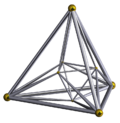Cross-polytope: Difference between revisions
m Robot - Moving category 4-dimensional geometry to Category:Four-dimensional geometry per CFD at Wikipedia:Categories for discussion/Log/2011 August 4. |
|||
| Line 64: | Line 64: | ||
| [[1-polytope|1]] |
| [[1-polytope|1]] |
||
!β<sub>1</sub> |
!β<sub>1</sub> |
||
|[[Line segment]]<BR>1-orthoplex |
|[[Edge (geometry)|Line segment]]<BR>1-orthoplex |
||
|[[Image:Cross graph 1.svg|50px]] |
|[[Image:Cross graph 1.svg|50px]] |
||
| |
| |
||
Revision as of 11:38, 18 August 2011
In geometry, a cross-polytope,[1] orthoplex,[2] hyperoctahedron, or cocube is a regular, convex polytope that exists in any number of dimensions. The vertices of a cross-polytope are all the permutations of (±1, 0, 0, …, 0). The cross-polytope is the convex hull of its vertices. Its facets are simplexes of the previous dimension, while the cross-polytope's vertex figure is another cross-polytope from the previous dimension.
The n-dimensional cross-polytope can also be defined as the closed unit ball (or, according to some authors, its boundary) in the ℓ1-norm on Rn:
In 1 dimension the cross-polytope is simply the line segment [−1, +1], in 2 dimensions it is a square (or diamond) with vertices {(±1, 0), (0, ±1)}. In 3 dimensions it is an octahedron—one of the five convex regular polyhedra known as the Platonic solids. Higher-dimensional cross-polytopes are generalizations of these.

|

|

| ||
| 2 dimensions square |
3 dimensions octahedron |
4 dimensions 16-cell |
The cross-polytope is the dual polytope of the hypercube. The 1-skeleton of a n-dimensional cross-polytope is a Turán graph T(2n,n).
4 dimensions
The 4-dimensional cross-polytope also goes by the name hexadecachoron or 16-cell. It is one of six convex regular 4-polytopes. These polychora were first described by the Swiss mathematician Ludwig Schläfli in the mid-19th century.
Higher dimensions
The cross polytope family is one of three regular polytope families, labeled by Coxeter as βn, the other two being the hypercube family, labeled as γn, and the simplices, labeled as αn. A fourth family, the infinite tessellations of hypercubes, he labeled as δn.
The n-dimensional cross-polytope has 2n vertices, and 2n facets (n−1 dimensional components) all of which are n−1 simplices. The vertex figures are all n − 1 cross-polytopes. The Schläfli symbol of the cross-polytope is {3,3,…,3,4}.
The number of k-dimensional components (vertices, edges, faces, …, facets) in an n-dimensional cross-polytope is given by (see binomial coefficient):
The volume of the n-dimensional cross-polytope is
There are many possible orthographic projections that can show the cross-polytopes as 2-dimensional graphs. Petrie polygon projections map the points into a regular 2n-gon or lower order regular polygons. A second projection takes the 2(n-1)-gon petrie polygon of the lower dimension, seen as a bipyramid, projected down the axis, with 2 vertices mapped into the center.
| n | βn k11 |
Name(s) Graph |
Graph 2n-gon |
Graph 2(n-1)-gon |
Schläfli | Coxeter-Dynkin diagrams |
Vertices | Edges | Faces | Cells | 4-faces | 5-faces | 6-faces | 7-faces | 8-faces | 9-faces | |
|---|---|---|---|---|---|---|---|---|---|---|---|---|---|---|---|---|---|
| 1 | β1 | Line segment 1-orthoplex |
{} | 2 | |||||||||||||
| 2 | β2 −111 |
Bicross square 2-orthoplex |

|

|
{4} {} x {} |
4 | 4 | ||||||||||
| 3 | β3 011 |
Tricross octahedron 3-orthoplex |

|

|
{3,4} {30,1,1} |
6 | 12 | 8 | |||||||||
| 4 | β4 111 |
Tetracross 16-cell 4-orthoplex |

|

|
{3,3,4} {31,1,1} |
8 | 24 | 32 | 16 | ||||||||
| 5 | β5 211 |
Pentacross 5-orthoplex |

|

|
{33,4} {32,1,1} |
10 | 40 | 80 | 80 | 32 | |||||||
| 6 | β6 311 |
Hexacross 6-orthoplex |

|

|
{34,4} {33,1,1} |
12 | 60 | 160 | 240 | 192 | 64 | ||||||
| 7 | β7 411 |
Heptacross 7-orthoplex |

|

|
{35,4} {34,1,1} |
14 | 84 | 280 | 560 | 672 | 448 | 128 | |||||
| 8 | β8 511 |
Octacross 8-orthoplex |

|

|
{36,4} {35,1,1} |
16 | 112 | 448 | 1120 | 1792 | 1792 | 1024 | 256 | ||||
| 9 | β9 611 |
Enneacross 9-orthoplex |

|

|
{37,4} {36,1,1} |
18 | 144 | 672 | 2016 | 4032 | 5376 | 4608 | 2304 | 512 | |||
| 10 | β10 711 |
Decacross 10-orthoplex |

|

|
{38,4} {37,1,1} |
20 | 180 | 960 | 3360 | 8064 | 13440 | 15360 | 11520 | 5120 | 1024 | ||
| ... | |||||||||||||||||
| n | βn k11 |
n-cross n-orthoplex |
{3n − 2,4} {3n − 3,1,1} |
2n 0-faces, ... k-faces ..., 2n (n-1)-faces | |||||||||||||
The vertices of an axis-aligned cross polytope are all at equal distance from each other in the Manhattan distance (L1 norm). Kusner's conjecture states that this set of 2d points is the largest possible equidistant set for this distance.[3]
See also
- List of regular polytopes
- Hyperoctahedral group, the symmetry group of the cross-polytope
Notes
- ^ Elte, E. L. (1912), The Semiregular Polytopes of the Hyperspaces, Groningen: University of Groningen Chapter IV, five dimensional semiregular polytope [1]
- ^ Conway calls it an n-orthoplex for orthant complex.
- ^ Guy, Richard K. (1983), "An olla-podrida of open problems, often oddly posed", American Mathematical Monthly, 90 (3): 196–200.
References
- Coxeter, H. S. M. (1973). Regular Polytopes (3rd ed. ed.). New York: Dover Publications. pp. 121–122. ISBN 0-486-61480-8.
{{cite book}}:|edition=has extra text (help) p. 296, Table I (iii): Regular Polytopes, three regular polytopes in n-dimensions (n>=5)
External links
- Weisstein, Eric W. "Cross polytope". MathWorld.
- Polytope Viewer[dead link] (Click <polytopes...> to select cross polytope.)
- Olshevsky, George. "Cross polytope". Glossary for Hyperspace. Archived from the original on 4 February 2007.





